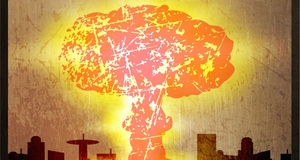Developing Weirdness Through Cartographic Destabilization in Jeff VanderMeer's Annihilation
By
2015, Vol. 7 No. 05 | pg. 1/2 | » AbstractThe spatial role of weird fiction seems to be one of dislocation, disorientation, and destabilization in what Ann and Jeff VanderMeer call weird fiction’s ability to “entertain while also expressing our own dissatisfaction with, and uncertainty about, reality” (VanderMeer, 2011, p. xv). Rather than being a form in which the reader finds a sense-of-place in the literature, weird authors use signifiers of dislocation and disorientation to convey a unique sense of weirdness, creating a dislocating dialectic between the weird spaces of the literature and the reader. In the opening lines of Jeff VanderMeer’s own novel, Annihilation (2014), we see this disorientation between reality and the self emerge. In this essay, I explore the notion of cartographic destabilization, a terminology drawn from the works of spatial theorists Edward Soja, Michel de Certeau, and Frederic Jameson in which the reader’s disorientation with the narrative spaces of literature constructs a mimetic metaphor for the weirdness of our own everyday lives. The continuous use of inherently spatial terminology such as disorientation and dislocation suggests a need for a spatially structured analysis of weird literature as a mode that attempts to map what Ann and Jeff VanderMeer (2011) call our own “dissatisfaction with, and uncertainty about, reality” (2011, p. xv) through the spatial metaphors present within weird fiction. Weird spaces and places such as those in the stories of H.P. Lovecraft, Jorge Louis Borges, Robert Aickman, and more recently those within Jeff VanderMeer’s Southern Reach Trilogy, project their unique sense of reality upon the story’s characters and its readers. This shapes the act of reading weird literature into a strange dialectic between the weird spaces presented by the story and the subjective interpretations of the reader as they attempt to find the meaning or logic behind the uncanny reality presented by weird fiction. More often than not the effect is one in which the reader must orient themselves against those weird spaces as they attempt to navigate their way through the tale, in effect attempting to map the weird. However, the weird seems to always reject this attempt at finding a sense of place during the reading. Characters are continuously presented with new monstrosities and their sense of reality is consistently challenged. Rarely do these characters find their own sense of place within the weird, but if they do they come across as changed or uncanny. This all comes together to only further destabilize a reader’s cognitive map of the literature. Jeff VanderMeer’s own novel, Annihilation, serves as a prime example of this sense of cartographic destabilization within the weird mode, particularly when considering the weird spaces of Area X that the twelfth expedition team must journey throughout the course of the novel. Interactions the biologist—Annihilation’s leading character—has with Area X and its other inhabitants construct a mimetic metaphor for the dislocating socio-spatial dialectic between the reader and the weird spaces of literature as well as how the dialectic transmutes itself throughout the course of the novel. VanderMeer and other authors of weird literature use this dialectic to construct cartographic destabilization, a sublime trap placed for the reader to fall into in which they cannot form a cognitive map of themselves in relation to the totality of the literature (Jameson, 1991, p. 51). This frees the reader from the constraints of a sense of place, a both terrifying and blissful prospect for them. Using what de Certeau (1984) describes as “the metamorphosis of the text effected by the wandering eyes of the reader” (p. xxi) against the reader, VanderMeer includes symbols and metaphors of dislocation and disorientation as the reader’s sense of place begins to slip into the author’s created space (de Certeau, 1984, xxi). It is a notion similar to geographer Edward Soja’s (1989) analysis of “the essentially dialectical character of social and spatial relationships” (p. 77) in which he dissects David Harvey’s idea that space and the organization of space does not just “reflect or express social relationships, but reacts back upon them” (as cited in Soja, 1989, p. 76). The literature becomes an author’s produced space in which the words on the page become the map that the reader uses to navigate the literary space of the novel, however as weird literature projects itself upon the reader the reader’s sense of place is disrupted by the destabilizing metaphors presented by the dislocating dialectic. Upon analysis of this dislocating dialectic we begin to see the map forming within Annihilation as one not just for the text itself, but as a map for reading weird fiction; a map that in its projection emphasizes a spatial analysis of weird fiction’s dialogue with the reader in interpreting its uniquely disorienting effect, and the construction of cartographic destabilization. A dislocating dialectic is emphasized as early as the opening line of the novel in which the expedition team is faced with a “tower [that is] not supposed to be there” (VanderMeer, Annihilation 3). As one of the first interactions the expedition team has with Area X, and the very first interaction the reader has with the novel, the reader/literature dialectic is formed alongside the expedition/Area X socio-spatial dialectic. The choice terminology of the sentence creates the initial unease between the reader and the novel by building a barrier of distrust with the dialectic itself. Annihilation tells the reader they’ve been lied to off the page before they have even read past the first sentence, creating a sense of doubt or suspicion with the novel that will continue to reinforce the barriers in the dislocating dialectic that keeps the reader from finding a sense of place within the novel. Unable to trust the weird spaces of the novel being presented, and without a sense of place to guide them, the reader’s development of a cognitive map of the literature is disrupted. This sense of unease and distrust is continuously built throughout the whole of the first chapter as the reader’s reactions to the dislocating dialectic begin to mirror the expedition team’s reactions to the tower and Area X. Like the reader, the expedition team has been left without any navigational equipment that they can trust. They are “forbidden watches and compasses” (VanderMeer, 2014, p. 4) and of the two maps they have brought with them, neither seems trustworthy as neither shows the tower they’ve encountered anywhere in Area X. Even their own bodily senses have been disrupted by “a low, powerful moaning at dusk” (VanderMeer, 2014, p. 5) which the biologist describes as having “dulled our ability to gauge direction, so that the sound seemed to infiltrate the black water that soaked the cypress trees” (VanderMeer, 2014, p. 5). In creating this atmosphere of disorientation, VanderMeer expresses within his novel that unique sense of being lost when reading weird fiction, a feeling generated by the dislocating dialectic and the awkward synthesis of weird spaces and the reader’s sense of place. With this in mind, we can look at these early scenes within the novel as self-examination of the dislocating dialectic the novel has created. The unease and distrust of their own senses experienced by the expedition members becomes a metaphoric representation of the distrust the reader feels when reading weird literature. The “forbidden watches and compasses” (VanderMeer, 2014, p. 4) represent the readers own navigational tools when interpreting literature, which the reader is denied when reading weird fiction, that whole expression of their selfhood: their sense of place in the story. Upon synthesis of the reader’s sense of place with the disorienting spaces of weird literature, the reader is left without a stable cognitive map in which to acclimate themselves to the space of the novel. This is where weirdness becomes more than just a feeling, but a mode in which the literature is written. It is the unique images and symbols of disorientation within weird fiction that signify the sense of displacement affected by the synthesis of a dislocating socio-spatial dialectic generated by weird fiction within the reader. Once a dislocating dialectic has been formed between the reader and weird fiction, we begin to see a destabilizing cartography form, affected by both reader and author. The author includes the symbols and metaphors of displacement, disorientation, and dislocation that geographically signify weirdness when constructing the text or their created space. Since the language the author uses acts as the map for the reader to navigate this space, the author—by using significations of that “sense of dislocation from mundane reality” (Barron, 2014, p. 15)—develops a map purposely designed to make its reader feel or become lost. When this process creates a dislocating dialectic with the reader, cartographic destabilization can fully form and create the aura of weirdness that will permeate throughout the whole of the story for it is the reader’s own mapmaking that actualizes that uniquely weird brand of horror. Here our focus shifts to the figure of the map in Annihilation as it becomes useful in understanding and dissecting the unique projections of the reader when establishing a cognitive map within literature and its relation to the development of weird fiction. Annihilation is unique in that it contains multiple apparent examples of maps both in their literal and metaphoric sense throughout the novel. The first instance of a map we encounter in the novel is the figure of the map in the literal sense, though it carries a metaphoric purpose. As the expedition comes across the tower in Area X, the twelfth expedition’s maps are used as tools to establish a dislocating dialectic. However, VanderMeer also uses this map to emphasize the expedition’s orientation with Area X as they use the map to cling to the familiar. Metaphorically, this represents the reader clinging to their original sense of self and place before being faced with the weird. In one such instance, the psychologist, in attempting to settle the restless expedition team, claims they are “to put [their] faith in [their] measurements” (VanderMeer, 2014, p. 18) which become just another form of map. To reinforce this idea, the psychologist examines the tower and says: This structure is 61.4 feet in diameter. It is raised 7.9 inches from the ground. The stairwell appears to have been positioned at or close to due north, which may tells us something about its creation, eventually. It is made of stone and coquina, not of metal or of bricks. These are facts. That it wasn’t on the maps means only that a storm may have uncovered the entrance. (VanderMeer, 2014, p. 18) The biologist finds the explanation “endearing” (VanderMeer, 2014, p. 18) and it’s interesting to read this as the biologist finding the psychologist’s cognitive map, her projection of Area X, as a form of comfort or place. The psychologist turns measurements into another kind of map, one whose projection relies on hard indisputable facts.Continued on Next Page » Suggested Reading from Inquiries Journal
Inquiries Journal provides undergraduate and graduate students around the world a platform for the wide dissemination of academic work over a range of core disciplines. Representing the work of students from hundreds of institutions around the globe, Inquiries Journal's large database of academic articles is completely free. Learn more | Blog | Submit Latest in Literature |


















